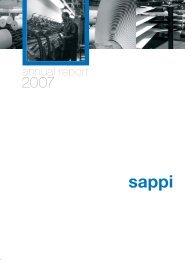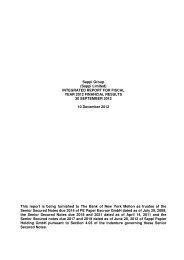2008 Annual report - Sappi
2008 Annual report - Sappi
2008 Annual report - Sappi
You also want an ePaper? Increase the reach of your titles
YUMPU automatically turns print PDFs into web optimized ePapers that Google loves.
sappi //<br />
30. Financial instruments (continued)<br />
Commodity risk<br />
Commodity risk arises mainly from price volatility and threats to security of supply.<br />
A combination of contract and spot deals are used to manage price volatility and contain costs. Contracts are limited to the<br />
group's own use requirements. The group aims to improve its understanding of the direction, magnitude and duration of future<br />
commodity price changes and to develop commodity specific expertise.<br />
The group manages security of supply by establishing alternate sources of supply and focusing on products and processes<br />
that allow the use of alternative commodities. <strong>Sappi</strong> examines its supply and quality risk on an ongoing basis with the view<br />
to continuously improve its commodity management practices.<br />
During <strong>2008</strong> we have not contracted any derivatives with respect to commodities.<br />
b) Credit risk<br />
Credit risk refers to the risk that a counterparty will default on its contractual obligations resulting in a financial loss to the<br />
group. The group faces credit risk in relation to trade receivables, cash deposits and financial investments.<br />
Credit risk relating to trade debtor management is the responsibility of regional management and is co-ordinated on a<br />
group basis.<br />
The group’s objective in relation to credit risk is to limit the exposure to credit risk through specific group-wide policies and<br />
procedures. Credit control procedures are designed to ensure the effective implementation of best trade receivable practices,<br />
the comprehensive maintenance of all related records, and effective management of credit risk for the group.<br />
The group assesses the credit worthiness of potential and existing customers in line with the credit policies and procedures.<br />
Appropriate collateral is obtained to minimise risk. Exposures are monitored on an ongoing basis utilising various <strong>report</strong>ing<br />
tools which highlight potential risks.<br />
In the event of deterioration of credit risk, the appropriate measures are taken by the regional credit management. All known<br />
risks are required to be fully disclosed, accounted for, and provided for as bad debts in accordance with the applicable<br />
accounting standards.<br />
Quantitative disclosures on credit risk are included in note 16 of the annual financial statements.<br />
A large percentage of our trade receivables are credit insured.<br />
Hedge accounting<br />
The group has the following fair value hedges which qualify for hedge accounting:<br />
Bonds at fixed interest rates for a total notional amount of US$856 million are hedged by seven external interest rate swaps<br />
(IRS). These IRS with a positive fair value of US$18.7 million convert the US$ fixed interest rates into floating 6-month LIBOR<br />
set in arrears. The hedged risk is designated to be the interest rate risk arising from fluctuations in the US LIBOR swap curve.<br />
The effect of this transaction is to convert fixed rate debt into floating rate debt.<br />
In fiscal 2005 the hedge was de-designated at the end of March, April and June 2005 respectively and was only re-designated<br />
in June 2005. During this period, hedge accounting was interrupted for a certain number of deals. The changes in fair value<br />
of the bonds until the moment of de-designation are amortised over the remaining life of the hedge.<br />
// <strong>2008</strong> <strong>Annual</strong> <strong>report</strong><br />
159
















